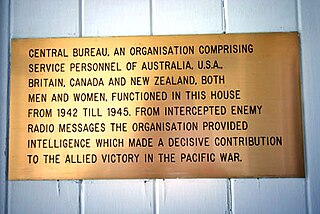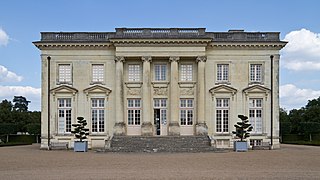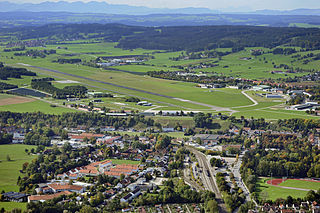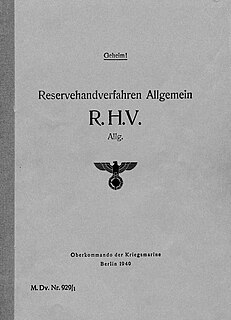 W
WBeaumanor Hall is a stately home with a park in the small village of Woodhouse on the edge of the Charnwood Forest, near the town of Loughborough in Leicestershire, England. The present hall was built in 1842–8 by architect William Railton and builder George Bridgart of Derby, for the Herrick family, with previous halls dating back to the 14th century, and is a Grade II* listed building It was used during the Second World War for military intelligence. It is now owned by Leicestershire County Council as a training centre, conference centre and residential facility for young people.
 W
WThe Benson House, listed on the National Register of Historic Places as the Wading River Radio Station, is a three-story, red-shingled wood-frame home in Wading River, New York, situated on the North Shore of Long Island, on a 150-foot-high (46 m) bluff overlooking Long Island Sound. From 1942 until 1945 it housed an important World War II counterintelligence operation, designed to deceive Germany and Japan about Allied war plans.
 W
WBletchley Park is an English country house and estate in Milton Keynes (Buckinghamshire) that became the principal centre of Allied code-breaking during the Second World War. The mansion was constructed during the years following 1883 for the financier and politician Sir Herbert Leon in the Victorian Gothic, Tudor, and Dutch Baroque styles, on the site of older buildings of the same name.
 W
WThe Central Bureau was one of two Allied signals intelligence (SIGINT) organisations in the South West Pacific area (SWPA) during World War II. Central Bureau was attached to the headquarters of the Allied Commander of the South West Pacific area, Douglas MacArthur. Central Bureau's role was to research and decrypt intercepted Imperial Japanese Army traffic and work in close co-operation with other SIGINT centres in the USA, United Kingdom and India. Air activities included both army and navy air forces, as there was no independent Japanese Air Force.
 W
WThe Chateau de Pignerolle is located to the east of Angers in the commune of Saint-Barthélemy-d'Anjou in the department of Maine-et-Loire in France.
 W
WThe Discriminant Book shortened to K-Book (K. Buch), and also known as the indicator group book or identification group book was a secret distribution list in booklet form, which listed trigraphs in random order. The Kenngruppenbuch was introduced in May 1937, and used by the Kriegsmarine during World War II as part of the Naval Enigma message encipherment procedure, to ensure secret and confidential communication between Karl Dönitz, Commander of Submarines (BdU) in the Atlantic and in the Mediterranean operating German submarines. The Kenngruppenbuch was used in the generation of the Enigma message Key that was transmitted within the message Indicator. The Kenngruppenbuch was used from 5 October 1941, for the Enigma Model M3, and from 1 February 1942 exclusively for the Enigma M4. It must not be confused with the Kenngruppenheft which was used with the Short Signal Book.
 W
WThe Enigma machine is an encryption device developed and used in the early- to mid-20th century to protect commercial, diplomatic and military communication. It was employed extensively by Nazi Germany during World War II, in all branches of the German military. Germany's use of the Enigma machine gave them the unique ability to communicate securely and a huge advantage in World War II. The Enigma machine was considered to be so secure that even the most top secret messages were sent via its electrical circuits.
 W
WThe Far East Combined Bureau, an outstation of the British Government Code and Cypher School, was set up in Hong Kong in March 1935, to monitor Japanese, and also Chinese and Russian (Soviet) intelligence and radio traffic. Later it moved to Singapore, Colombo (Ceylon), Kilindini (Kenya), then returned to Colombo.
 W
WFish was the UK's GC&CS Bletchley Park codename for any of several German teleprinter stream ciphers used during World War II. Enciphered teleprinter traffic was used between German High Command and Army Group commanders in the field, so its intelligence value (Ultra) was of the highest strategic value to the Allies. This traffic normally passed over landlines, but as German forces extended their geographic reach beyond western Europe, they had to resort to wireless transmission.
 W
WGerman Army cryptographic systems of World War II were based on the use of three types of cryptographic machines that were used to encrypt communications between units at the division level. These were the Enigma machine, the teleprinter cipher attachment, and the cipher teleprinter the Siemens and Halske T52,. All were considered insecure.
 W
WGerman Intercept Station Operations were intercept operations that were undertaken by the German Army forces in Europe during World War II. Interception is the gathering of radio signals as part of a signals intelligence operation.
 W
WKaufbeuren Air Base is a German Air Force military airbase. It is currently the home of the Luftwaffe Technical School 1.
 W
WThe Lorenz SZ40, SZ42a and SZ42b were German rotor stream cipher machines used by the German Army during World War II. They were developed by C. Lorenz AG in Berlin. The model name SZ was derived from Schlüssel-Zusatz, meaning cipher attachment. The instruments implemented a Vernam stream cipher.
 W
WThe Military Intelligence Service was a World War II U.S. military unit consisting of two branches, the Japanese American unit described here and the German-Austrian unit based at Camp Ritchie, described partly in Ritchie Boys. The unit described here was primarily composed of Nisei who were trained as linguists. Graduates of the MIS language school (MISLS) were attached to other military units to provide translation, interpretation, and interrogation services.
 W
WReservehandverfahren (RHV) was a German Naval World War II hand-cipher system used as a backup method when no working Enigma machine was available.
 W
WThe Schlüsselgerät 41, also known as the SG-41 or Hitler mill, was a rotor cipher machine, first produced in 1941 in Nazi Germany, that was designed as a potential successor for the Enigma machine. It saw limited use by the Abwehr towards the end of World War II.
 W
WThe Siemens & Halske T52, also known as the Geheimschreiber, or Schlüsselfernschreibmaschine (SFM), was a World War II German cipher machine and teleprinter produced by the electrical engineering firm Siemens & Halske. The instrument and its traffic were codenamed Sturgeon by British cryptanalysts.
 W
WUltra was the designation adopted by British military intelligence in June 1941 for wartime signals intelligence obtained by breaking high-level encrypted enemy radio and teleprinter communications at the Government Code and Cypher School (GC&CS) at Bletchley Park. Ultra eventually became the standard designation among the western Allies for all such intelligence. The name arose because the intelligence obtained was considered more important than that designated by the highest British security classification then used and so was regarded as being Ultra secret. Several other cryptonyms had been used for such intelligence.
 W
WThe United States Naval Computing Machine Laboratory (NCML) was a highly secret design and manufacturing site for code-breaking machinery located in Building 26 of the National Cash Register (NCR) company in Dayton, Ohio and operated by the United States Navy during World War II. It is now on the List of IEEE Milestones, and one of its machines is on display at the National Cryptologic Museum.